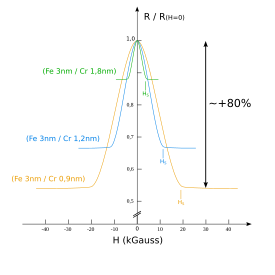GMR effect
The GMR effect ( English giant magnetoresistance ) or giant magnetoresistance based on a magnetoresistive effect , and is observed in structures of alternating magnetic and non-magnetic thin layers with few nanometers consist layer thickness. The effect has the effect that the electrical resistance of the structure depends on the mutual orientation of the magnetization of the magnetic layers, and in fact it is significantly higher when magnetized in opposite directions than when magnetized in the same direction.
It is mainly used in magnetic hard drives .
discovery
The effect was first discovered in 1988 by Peter Grünberg from Forschungszentrum Jülich and Albert Fert from the University of Paris-Süd in independent work, for which they were jointly awarded the Nobel Prize in Physics in 2007 .
Explanation
The GMR effect is a quantum mechanical effect that can be explained by the spin dependence of the scattering of electrons at interfaces . Electrons that can propagate well in one of the two ferromagnetic layers because their spin is favorably oriented are heavily scattered in the second ferromagnetic layer if it is magnetized in the opposite direction. However, they pass through the second layer much more easily if the magnetization has the same direction as in the first layer.
application

There are two round permanent magnets on the end of the exhibit. In the middle is the GMR sensor in black. This can be moved back and forth between the permanent magnets by turning the knob at the end of the slotted brass shaft. Due to the shift in the magnetic field, the sensor changes its electrical resistance. This resistance can be measured electronically and converted into the exact position of the sensor between the magnets.
If two layers of a ferromagnetic material are separated by a thin non-magnetic layer, the magnetizations align themselves in opposite directions at certain thicknesses of the intermediate layer. Even small external magnetic fields are enough to switch this antiferromagnetic order back into the ferromagnetic order.
In connection with the GMR effect, variations in the external magnetic field in suitable structures therefore cause large changes in the electrical resistance of the structure.
The possibilities of using the effect in a magnetic field sensor (and thus as a new type of read head in a hard disk drive ) were quickly discovered by an IBM research team led by Stuart Parkin , when they showed that the effect could also be used in polycrystalline Layers occurs.
In the application of the effect one differentiates today between the following cases:
- Two ferromagnetic planes are separated by a very thin (approx. 1 nm) non-ferromagnetic intermediate layer (English spacer ) (approx. Fe / Cr / Fe). Depending on the thickness of the intermediate layer, the RKKY coupling between the two ferromagnets ensures that a parallel or an anti-parallel alignment is energetically preferred. The electrical resistance of this unit is usually higher in an anti-parallel orientation, the difference being more than 10% at room temperature.
- Two ferromagnetic planes are separated by a (about 3 nm) thin non-ferromagnetic intermediate layer (English spacer ) without RKKY coupling. If the coercive field strengths of the two ferromagnetic electrodes are different, i. This means that one of the two layers is "magnetically harder" than the other, it is possible to change the direction of magnetization of the "softer" layer independently of that of the "harder" one. As a result, a parallel and an anti-parallel alignment of the magnetization direction can be achieved, the electrical resistance in the anti-parallel case again normally being higher. This component is sometimes referred to as spin valve (English spin-valve ), respectively.
commercial use
In December 1997, IBM manufactured the first commercial hard drive that used the GMR effect. Other applications are magnetic field sensors in automobiles.
The use of the effect in non-volatile storage media (see MRAM ) was not yet ready for the market in 2010.
See also
Web links
- Website about Peter Grünberg and background information on the GMR effect
- Coupling makes the resistance of P. Grünberg
swell
- ↑ Information from the Nobel Foundation on the 2007 award ceremony for Albert Fert and Peter Grünberg (English)

